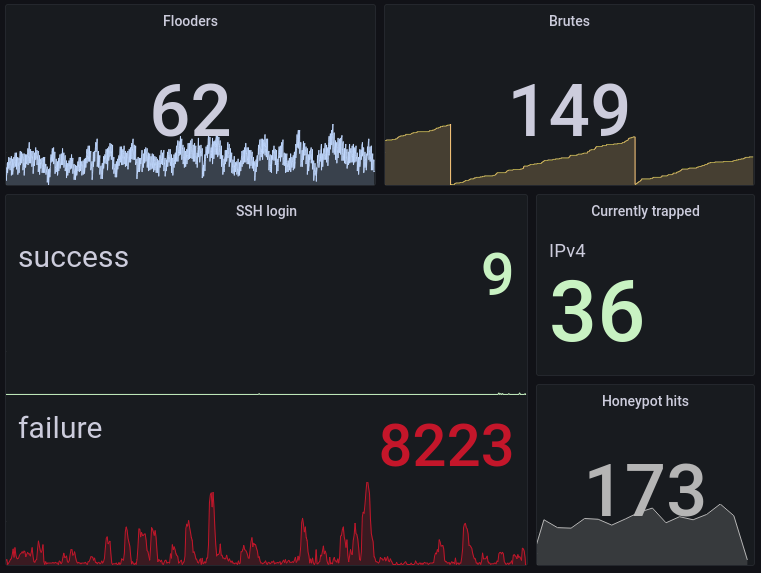In the past two weeks I set up a new VPS, and I run a small experiment. I share the results for those who are curious.
Consider that this is a backup server only, meaning that there is no outgoing traffic unless a backup is actually to be recovered, or as we will see, because of sshd.
I initially left the standard “port 22 open to the world” for 4-5 days, I then moved sshd to a different port (still open to the whole world), and finally I closed everything and turned on tailscale. You find a visualization of the resulting egress traffic in the image. Different colors are different areas of the world. Ignore the orange spikes which were my own ssh connections to set up stuff.
Main points:
-
there were about 10 Mb of egress per day due just to sshd answering to scanners. Not to mention the cluttering of access logs.
-
moving to a non standard port is reasonably sufficient to avoid traffic and log cluttering even without IP restrictions
-
Tailscale causes a bit of traffic, negligible of course, but continuous.
Public key auth, and fail2ban on an extremely strict mode with scaling bantime works well enough for me to leave 22 open.
Fail2ban will ban people for even checking if the port is open.
Honest question, is there a good default config available somewhere or is what
apt install fail2bandoes good to go? All the tutorials I’ve found have left it to the reader to configure their own rules.Honestly the default config is good enough to prevent brute force attacks on ssh. Just installing it and forgetting about it is a definite option.
I think the default block time is 10 minutes after 5 failed login attempts in 10 minutes. Not enough to ever be in your way but enough to fustrate any automated attacks. And it’s got default config for a ton of services by default. Check your /etc/fail2ban/jail.conf for an overview.
I see that a recidive filter that bans repeat offenders for a week after 10 fail2ban bans in one day is also default now. So I’d say that the results are perfect unless you have some exotic or own service you need fail2ban for.
Yeah fail2ban has worked great for me
If Fail2Ban is so important, why the h*** does it not come installed and enabled as standard?!
Security is the number-1 priority for any OS, and yet stock SSHD apparently does not have Fail2Ban-level security built in. My conclusion is that Fail2Ban cannot therefore be that vital.
Or, you know, just use key auth only and fail2ban. Putting sshd behind another port only buys you a little time.
Yeah but the majority of bots out there are going after easy prey. Honestly, if you use public key authentication with ssh you should be fine, even if it is on port 22. But it does of course clog up access logs.
The majority of bots out there are stopped by just using a hard to guess password. It’s not them that you should be worried about.
The majority of bots doesn’t even show up in the logs if you disable password auth in the server config, as you typically should.
who should we be worried about?
I’ve noticed that a lot of the scans these days almost always switch IPs after 2-3 attempts, making IP blocking a lot more difficult.
Let’s say that you could ban for an indefinitely large amount of time after a single failure to authenticate, that’d make them run out of IPs much quicker than you’d run out of CPU/BW, so I don’t really see the issue
Potentially yeah, although a single failure means I might lock myself out by accident.
True, but very unlikely (once your ssh client is configured once and for all), and in that event you can always switch connection (use a data network, proxy, vpn, hop from another server you have ssh access, etc)
I opened a raw text channel on the Telnet port for a personal game engine project and someone tried to enable commands and do some shady stuff. Unfortunately for them, that’s not a valid chess move.
Just do it properly and configure sshd securely. When you have a machine exposed to the internet, you should expect it to be attacked. If you really want to give the finger to bots, run endlessh on port 22 and keep sshd on a non-standard port. Stay safe.
endlessh
Lmao thanks for this
Acronyms, initialisms, abbreviations, contractions, and other phrases which expand to something larger, that I’ve seen in this thread:
Fewer Letters More Letters DNS Domain Name Service/System HTTP Hypertext Transfer Protocol, the Web IP Internet Protocol SSH Secure Shell for remote terminal access UDP User Datagram Protocol, for real-time communications VPN Virtual Private Network VPS Virtual Private Server (opposed to shared hosting) nginx Popular HTTP server
7 acronyms in this thread; the most compressed thread commented on today has 8 acronyms.
[Thread #42 for this sub, first seen 14th Aug 2023, 15:55] [FAQ] [Full list] [Contact] [Source code]
Good bot!
Great bot
10mb is pretty much nothing. May as well just use Fail2Ban.
But it depends on the size of the network/system and how many devices have an open port and are open to connection.
It may not make a difference on 1 server, but if you have a full network with managed switches, routers, firewalls and access points would its impact become more significant?
Not a network expert, just a technician, and I’m curious so any insight is appreciated!
Only Internet facing devices would see this kind of traffic 10mb/day/per public IP address is still nothing unless you otherwise have essentially zero traffic. Typically only firewalls would have external IPs of the devices you mentioned and they wouldn’t have SSH bound to an external port
If you’re going to have lots of hosts running SSH you should setup a bastion/jump host for it anyways.
Well nothing compared to rest of the infrastructure, we are talking of 0.05$ per month per machine at standard egress rates of major cloud providers. Still, why having them?
This would be per public address. Generally you’ll keep those to a minimum for a properly configured cloud setup, and only have 1-5 of them for a local setup.
I’d favour own VPN instead of relying on an additional third party
Right? PiVPN is easy AF and uses WireGuard. No reason not to set up something yourself if you’re already selfhosting.
Please ELI5: How does this solution work? You tunnel yourself in your home network with a VPN on your PI? How is that safer, isn’t there still a port open?
If you do want to open 22, and there are plenty of good reasons to want to, just implement something called port knocking and you can do it safely.
Note with this you still need good authentication. That means no passwords, key based auth only.
I have read elsewhere that port knocking is just security through obscurity and isn’t worth considering. I found it when searching for ways to set it up and that put me off.
Security through obscurity is a very valid way to secure something. It shouldn’t be the only way of securing something, but it can be a valid additional layer.
The knock sequence is a secret, just like a password. It may not be a particularly strong secret, but is is strong enough to keep out casual attackers. You’ll still need additional security, but sshd is well equipped to provide that.
If you want to go down that path, a password is only security by obscurity.
Port knocking is an extra layer of security, and one that can stop attackers from ever knowing your private server even exists. A random scanner won’t even see any open ports.
Always bear in mind that any random guy advising people not to use port knocking may be doing it with malicious intent. I’m sure there’s someone out there advising that random passwords are a waste of time, and everyone should just use monkey123.
I get what you say, and you’re definitely not wrong to do it. But as I see it, you only saved ~80Kib of ingress and a few lines of logs in the end. From my monitoring I get ~5000 failed auth per day, which account for less than 1Mbps average bandwidth for the day.
It’s not like it’s consuming my 1Gbps bandwidth or threatening me as I enforce ssh key login. I like to keep things simple, and ssh on port 22 over internet makes it easy to access my boxes from anywhere.
I don’t get why people leave interfaces the public doesn’t need access to open to the public – especially SSH.
Use a VPN if you need access to those interfaces from the “outside”. They’re stupidly easy to set up these days, particularly with Wireguard.
A VPN is easy to setup (and I have it setup by the way), but no VPN is even easier. SSH by itself is sufficiently secure if you keep it up to date with a sane configuration. Bots poking at my ssh port is not something that bother me at all, and not part of any attack vector I want to be secure against.
Out of all the services I expose to the clear web, SSH is probably the one I trust the most.
I would generally agree with this a strong password and SSH without keys has never gone sideways for me and over 15 years of having public Linux servers. but I also make sure to install all security updates on a regular basis on any server no matter what SSH configuration is.
Agreed ! Also it would make graphs pretty boring ;)

Defense in depth – maybe I’m paranoid, but just because something is unlikely doesn’t mean an extra layer of security isn’t advantageous. Particularly when I already have a VPN, so there’s little reason not to use it.
Plus, my logs are easily checked as a side effect.
To each their own ! Security is a complex topic which usually resolves to adjusting the “security/annoyance” cursor to the best position.
In my case the constraints of using a VPN simply outweighs the security benefits.
ssh -p 12345 would leave your boxes accessible from anywhere too. Other blocks of IPs receive 10 times or more requests, as scanners can focus on blocks of ips from major providers.
Yeah I know, I just don’t really care about that traffic to bother changing it :) Also, I’m talking about a server hosted on Hetzner, so I feel like it’s scanned a lot.
You really shouldn’t have something kike SSHD open to the world, that’s just an unnecessary atrack surface. Instead, run a VPN on the server (or even one for a network if you have several servers on one subnet), connect to that then ssh to your server. The advantage is that a well setup VPN simply won’t respond to an invalid connection, and to an attacker, looks just like the firewall dropping the packet. Wireguard is good for this, and easy to configure. OpenVPN is pretty solid too.
You say this and are downvoted.
While we are coming off the tail of Def Con where there where a plethora or small talks and live examples of taking advantage and abusing just this.
Just trying to parse your comment, I assume your first “this” and second “this” are referring to different things, right?
I don’t understand your comment, what you are saying. Could you elaborate a bit, please? I’m interested why it’s a bad idea what previous comment suggested.
Of course I can dig into DefCon videos and probably would do if needed, but perhaps you know what exactly the issue is
The first this means the comment he answered to and the second one means ssh being used as an attack surface, being described in defCon talks
And yet it is more likely that tailscale get owned since the reward is much higher. I take my chances with my secured openssh server at port 22 vs a 3rd party company who controlls the access.
Just setup a wireguard system that’s pretty bulletproof
So is SSH
Wireguard doesn’t respond but I agree open-ssh is pretty solid. Can’t speak for any of the other ssh implementations. It can also be poorly configured. Like you could use a password
The benefit of Wireguard is that if you screw it up, it just won’t work. It basically enforces security.
Well, unless you tried to use the original PFSense module.
I don’t know if it was mentioned already but how could I check if my ports are under “attack”? OPs graphic looks really nice
Hi, to check attacks you should look at the logs. In this case auth.log. Being attacked on port 22 is not surprising neither really troublesome if you connect via key pair.
My graph was showing egress traffic, on any kind of server the traffic due to these attacks would have been invisible but on a backup server which has (hopefully) only ingress you can clearly see the volume of connections from attackers from bytes teansmitted
Throw CrowdSec on there to stop the bots before they can do anything
The best reason is reducing attack surface. It’s such an easy thing to do. I don’t know why people still expose services they don’t need to.
Moving the port doesn’t reduce attack surface. It’s the same amount of surface.
Tailscale is a bit controversial because it requires a 3rd party to validate connections, a 3rd party that is a large target for threat actors, and is reliant on profitability to stay online.
I would recommend a client VPN like wireguard, or SSH being validated using signed keys against a certificate authority your control, with fail2ban.
It reduces the probability that a drive by scanner is going to detect a vulnerable service. Camouflage isn’t a guarantee that you aren’t going to be sighted on a battlefield, but it’s still a good idea to reduce the probability of becoming a target in whatever ways you can.
I’ll take that tiny amount of traffic telling scanners there’s no password auth over having to remember port settings for ssh, scp and rsync any day.
My configs remember stuff for me.
vim ~/.ssh/configdeleted by creator
Fair point. These logs are only useless chatter anyway for everyone with proper key auth.
For me it’s not about the traffic, more the log spam.
Generally I’ll have :22 enabled internally, and anything non-standard is defined in
~/.ssh/configand shared out so I don’t have to remember things.

















